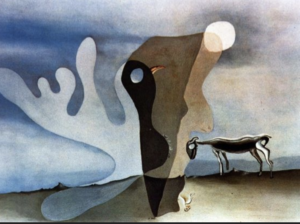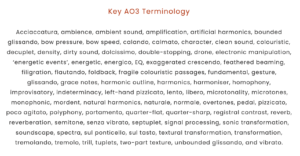LO 1-2: To explore the context of ‘Spectral Music’ and get familiar with Saariaho`s background and her style
Starter activity: Can you remember the names of 20-th century composers?
- Wider listnewing composers: which ones are 3 Odd One Out? Prepare to justify your answers
- Tristan Murail

- Gerard Grisey
- Varese
- Schumann
- Ligeti
- Debussy
- Ravel
- Messiaen
- Berio
- Bernstein
Core activity:
Answer the following questions/complete the tasks:
- What is the cellist name, to whom S dedicated the piece?
- What does ‘Indeterminate’ mean?
- What is the structure of Petals?
- What does she use instead of bar numbers?
- Mark the score (p.282), annotate the main features
- Make notes of the more ‘unusual’ or adventurous techniques used (p.283)
- Complete the worksheet: Saariaho context questions
Homework:
Listen to the piece and answer to the following questions:
- Listen to the opening staves 1-7. Describe the use of dynamics and microtonality
- Describe the role of rhythm that plays in Petals
- Listen to the final Lento section (stave 27). Describe the electronic effects and playing techniques used
- Listen to further works from the 20th and 21st centuries which create new sound worlds. In the mid 1950s Karlheinz Stockhausen integrated electronic sounds with the human voice in his classic early electronic piece ‘Gesang der Junglinge’.
The work is often referred to as an early “masterpiece of electronic music”. What is particularly significant is the synthesis of electronic/synthetic sounds with the human voice, i.e. with sung/natural sounds. It is therefore often seen as the first successful combination of the purely electronically produced music that was avant-garde in Germany at the time and the musique concrète that emerged in France . Sine and pulse generators and boys’ voices processed with tape technology are used to generate the sound .
LO3: To explore the musical devices used in Petals.
Starter activity:
- See the answers to the questions from Leson 2 Homework Petals answers and compare with your own version of it.
- List 6 general dynamics and articulation markings, which Saariaho uses in her composition.
- Explain what is harmonizer and reverb?
- Describe the difference between sul tasto and sul ponticello.
Core activity:
Answer the following questions/complete the tasks:
- Discuss in 2 sentences the overall usage of Dynamics.
- Evaluate why it says the texture in monophonic
- If we say there is a tonality in this piece of music which key do you think it might be?
- Read about the ‘Organisation of pitch and harmony’ p.285-287 and analyze the score?
- Evaluate the overall Tempo and Rhythm of the piece. Circle in your score the shortest and the longest durations.
- Do you know what is a tuplet?
Homework:
- Copy the key words and useful expressions into your Music Vocabulary
- Compare and evaluate which of the statements are technical details (AO3) and which ones are the musical expressions that imaginatively explains the effect created (AO4).

LO 4: To get familiar with the wider listening list and practise writing a context paragraph
Starter activity:
List 10 Ao3 terminology words from the previous lesson.
Core activity:
- Listen to 3 pieces from the list before Petals and after Petals LINK
- Spotify playlist HERE
- Describe Saarahio`s Musical language: The use of spectralism, electronic and acoustic integration, the use of extended techniques, spatialization and surround sound, rich harmonic language, expressive and evocative imagery, interdisciplinary collaboration and exploration of time and temporality LINK
Useful links:
Composer of the week https://www.bbc.co.uk/programmes/p08vcmnf
Homework:
Write 2 essays chosen from the list at the bottom of this page: LINK
